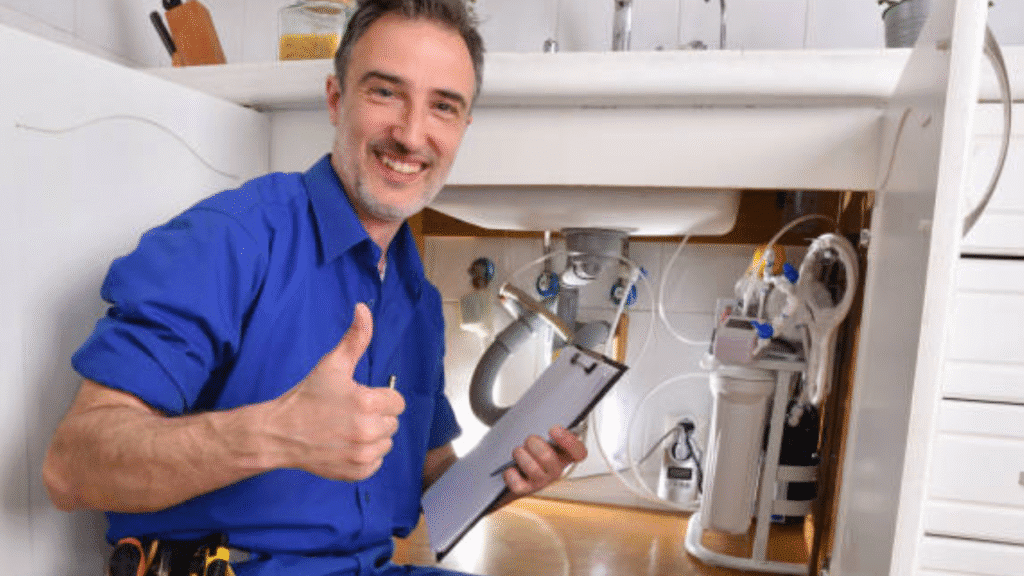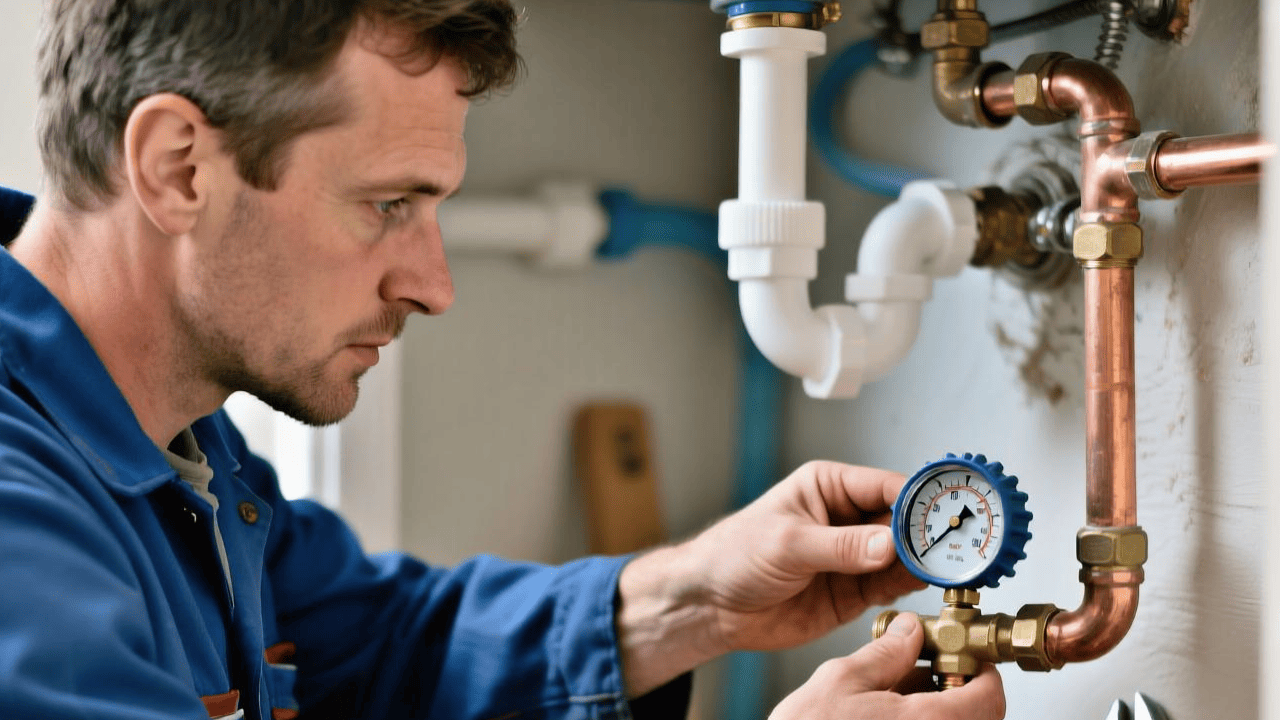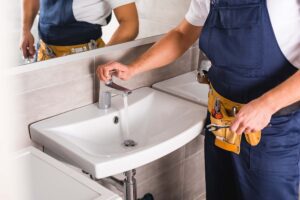| Key Takeaway Low water pressure at your home can be fixed by opening your main water valve, adjusting the meter valve, reading the pressure regulator, adjusting the pressure switch, replacing blocked pipes, and other solutions. |
Do you notice weak water flow when you shower, wash dishes, or water your plants?
Low water pressure is more than just an inconvenience–it can make daily routines frustrating and time-consuming. We have all been there—turning on the shower after a long day, only to find a trickle instead of a refreshing stream. It is not just frustrating; it might point to bigger plumbing issues.
But you don’t have to settle for poor water flow. Here we will dive into 9 solutions to low-water pressure.
What Causes Low Water Pressure?
1. Corroded Pipes
Corrosion inside pipes can reduce the space available for water to flow. This can usually be seen in older homes with metal pipes.
2. Building up of Scale from Hard Water
Minerals like calcium and magnesium in hard water build up scale inside the pipe.
3. Partially Closed or Faulty Valves
If the main water shutoff valve or other supply valve is not fully open, water pressure will be reduced.
4. Leaks
A small leak in plumbing lines inside or outside the home can reduce water pressure by allowing the water to escape.
5. Faulty Pressure Regulators
A pressure regulator controls the water pressure coming into your home. If it is malfunctioning or set too low, the water pressure will be low.
6. Water Treatment Systems
Incorrectly sized or malfunctioning water softeners or filters can cause pressure drops.
How Do You Know If You Have Low Water Pressure?

1. Weak Shower and Faucet Pressure
When you use showers or taps, you will notice that the water is noticeably weak or dribbles.
2. Slow Filling Bathtub and Kettle
A bathtub takes much longer than usual (more than 5 minutes) to fill, or your kettle takes longer than 30-40 seconds to fill.
3. Slow Toilet Refill
The toilet tank takes more than 2 minutes to refill after flushing.
4. Inconsistent Water Flow
The water pressure changes suddenly, especially when other appliances or fixtures are in use.
5. Difficulty Using Multiple Fixtures Simultaneously
Pressure drops significantly when multiple water-using fixtures operate at the same time.
6. Strange Noises
You will hear banging or knocking sounds in the plumbing when water is running.
7. Visible Signs
Discolored water or signs of leaks in the plumbing system also lead to low pressure.
8. Water Pressure Gauge Reading
When you use a water pressure gauge on an outside faucet, you can get a precise reading. Normal home water pressure is between 3 and 5.5 bars. Pressure below 2.7 bars indicates low water pressure.
How To Fix Low Water Pressure

Here you will know what to do if the water pressure is low in your home:
1. Open your Main Water Valve
After plumbing repairs or maintenance, the main shut-off valve might not be fully open, which can restrict water flow and cause low pressure. Follow these steps to open the main water valve:
- Locate the water shut-off valve, typically found where the water line enters your house. It could be in the basement, crawl space, or on an exterior wall.
- Turn the valve counterclockwise until it stops.
- Check other supply valves under sinks, near fixtures, or around appliances like water heaters or dishwashers.
If the valve is damaged or stuck, you may need to replace it or call professional plumbers for assistance.
2. Adjust the Meter Valves
Meter valves control the flow to the water meter and allow you to shut off the water supply for repairs, emergencies, or extended absences. If you have low water pressure, adjusting these valves may help. Follow these steps:
- Locate the water pressure reducing valve near the water meter where the main water line enters your home.
- Attach a pressure gauge to a faucet downstream from the valve to check the current pressure.Â
- Loosen the locknut on the adjustment screw.Â
- Turn the adjustment screw clockwise to increase pressure or counterclockwise to decrease it.
- Rotate the adjustment screw counterclockwise to decrease the water pressure.
- Make small adjustments and check the water pressure after each adjustment.Â
- Tighten the locknut once the desired pressure (between 40 and 80 PSI) is reached.
- Test faucets to ensure proper pressure and check for leaks around the valve, tightening fittings as needed.
3. Read the Pressure Regulator
Reading the pressure regulator is important because without it, you wouldn’t know if the regulator is the source of low water pressure or what adjustment is needed. Follow the process to read the regulator:
- Locate the pressure regulator valve near the main water line entering your home.Â
- Find the pressure gauge attached to or near the regulator, which measures water pressure after regulation.Â
- The gauge displays pressure in PSI (pounds per square inch) or bars.Â
- Read the current pressure on the gauge dial. (Note: Normal residential water pressure ranges between 40 and 60 PSI.)
- If the reading is outside this range, the regulator may need adjustment.Â
- If no gauge is present, you can temporarily attach a water pressure gauge to a faucet or hose bib downstream of the regulator to check the pressure.
4. Fix the Obstructed Shutoff Valve
An obstructed shutoff valve can cause low water pressure, leakage, or even water damage if left unchecked.
Here is how to fix an obstructed shutoff valve:
- Turn off the main water supply.Â
- Inspect the valve for any visible signs of blockages or mineral deposits.Â
- Disassemble the valve if needed using appropriate tools.Â
- Clean the valve.
- Reassemble the valve.
- Replace the valve if it is damaged, or if cleaning doesn’t solve the issue.
Avoid using the wrong tools or excessive force to open the valve, which can lead to damage.
5. Clean the Aerator
An aerator is typically a small device that is attached to the end of a faucet (also called a tap) that mixes air with the water stream. So, in case of low water pressure, you must:
- Locate the aerator at the tip of the faucet spout.Â
- Unscrew the aerator by hand or with a wrench; it is tight.Â
- Use a cloth around the aerator to avoid scratching.Â
- Disassemble the aerator carefully and remove the screen and other parts.Â
- Soak the parts in a mixture of vinegar and water for about 30 minutes to dissolve mineral deposits.Â
- Consider a small brush, toothpick, or old toothbrush to scrub the screen and parts to remove debris and buildup.Â
- Rinse all parts thoroughly with water. Reassemble the aerator components.Â
- Screw the aerator back onto the faucet.Â
- Turn on the faucet to test water flow and pressure.Â
6. Flush Your Water Heater
Regularly flushing your water heater can remove sediment buildup, affecting the water pressure.
How to Flush Your Water Heater
- Switch off the power to the water heater.
- Shut off the cold water supply valve to the heater.Â
- Connect a garden hose to the valve located at the base of the tank.
- Place the other part of the hose in a safe drainage location (e.g., outside or a floor drain).
- Open the drain faucet and let the tank empty fully.
- Turn on a hot water faucet inside your home to let air in and help the tank drain faster.
7. Replace Blocked Pipes
Mineral buildup and debris block the pipes. It results in low water pressure in homes. So, you should:
- Shut off the water and draining pipes
- Cut out the blocked section
- Install new pipes with proper fittings.
It is a high-precision task and needs specialized tools. So, it is important to take the help of a licensed plumbing company who have expertise and specialized tools.
8. Check for Leaks
According to the Environmental Protection Agency (EPA), leaks in the average home can waste about 10,000 gallons of water annually. Not only do leaks contribute to significant water loss over time, but they can also cause low water pressure.
How to Check for Leaks
- Check your water meter.
- Monitor your water bill.
- Looking for wet spots or damp patches.
- Listening for dripping, hissing, or running water sounds.
- Inspecting under sinks, around toilets, water heaters, dishwashers, and washing machines.
- Looking for signs on walls or ceilings, such as discoloration, warping, or damage.Â
If you are unable to locate a leak on your own, it is time to consider calling a professional plumber.
9. Install a Booster Pump
Are you experiencing consistently low water pressure throughout your home?
If yes, a booster pump can help increase flow rates and make sure you get the water pressure you need in every faucet, shower, and appliance.
How To Install a Booster Pump
- Shut off the main water supply.
- Cut the pipe where the pump goes.
- Add fittings, valves, and a check valve.
- Mount the pump securely.
- Connect it to pipes.
- Wire the pump to a power source for operation.
- Restore water supply and check for leaks.
- Test the water pressure and adjust as needed.
Who to Call for Low Water Pressure?

For low water pressure, the best step is to call a licensed plumbing company in the Simi Valley area—Sketchley & Mason Plumbing. Our experienced plumbers can find and fix clogged pipes, leaks, faulty valves, or pressure regulators that cause weak flow. Our emergency services can help with urgent issues like burst pipes or sudden water loss. Contact us today to quickly fix your poor water pressure issues and restore your home’s water flow.
Frequently Asked Questions (FAQs)
1. How to bring water pressure back up?
Check and adjust the pressure-reducing valve, ensuring it is fully open and properly set. If that doesn’t work, inspect and clean showerheads and faucet aerators, as mineral buildup can restrict flow.
2. What is a normal water pressure for a house?
A normal water pressure for a house typically falls within the range of 40 to 80 PSI (Pounds per square inch).
3. Can you adjust your own water pressure?
Yes, you can adjust water pressure using a pressure-reducing valve (PRV) on the main water line entering the house.
4. How to test the water pressure at your home?
Attach a pressure gauge to an outdoor faucet or hose bib. Ensure no water is running indoors or outdoors, then turn on the faucet. The gauge will show the pressure in PSI between 40-80. If readings are too high or low, consult a licensed plumber for help.
5. How to check if the water pressure is too low?
You can check low water pressure using a gauge on an outdoor faucet ( normal pressure is 40-80 PSI). It is too low. Alternatively, do a jug test–if it takes more than six seconds to fill a 1-liter jug, pressure is insufficient.



